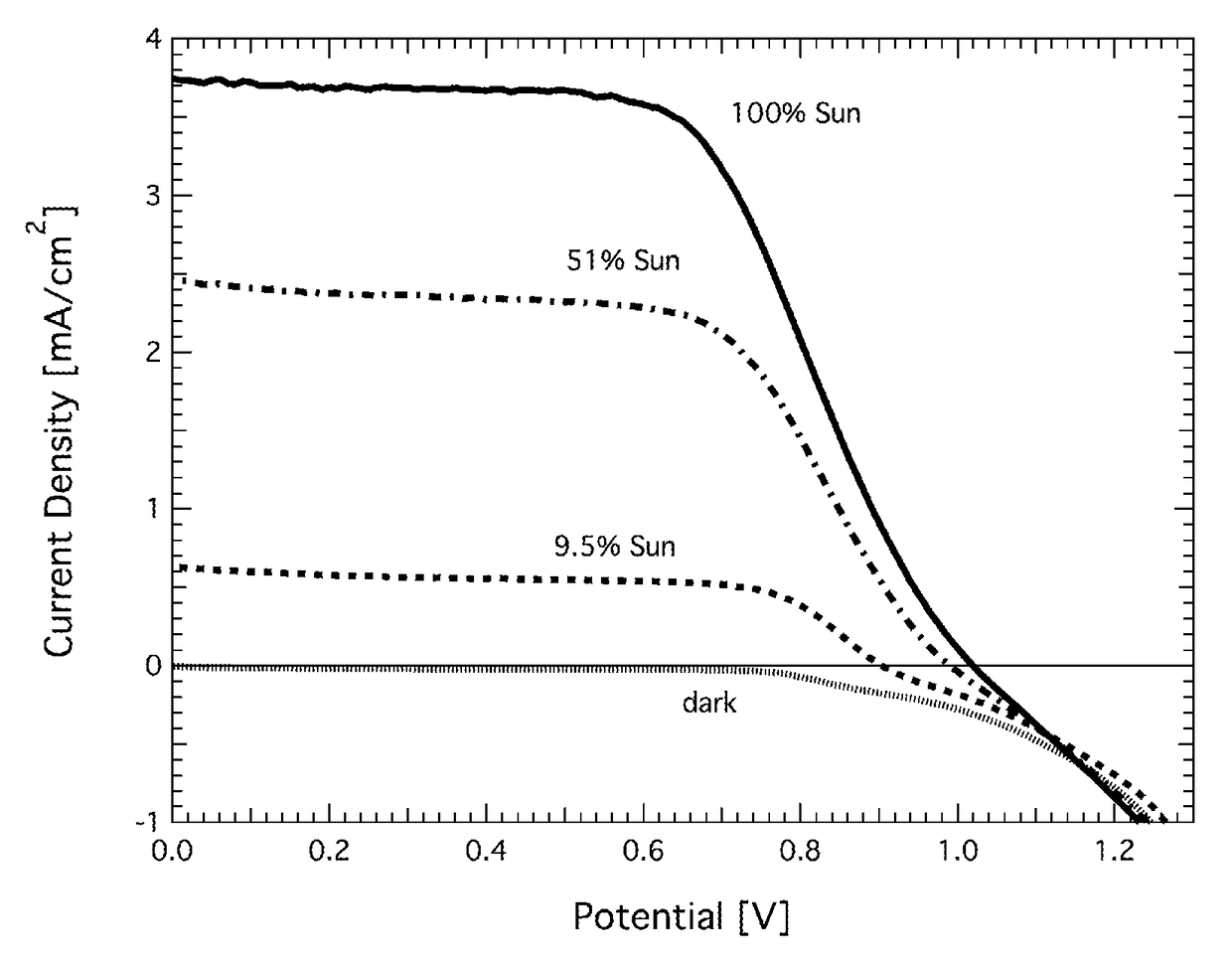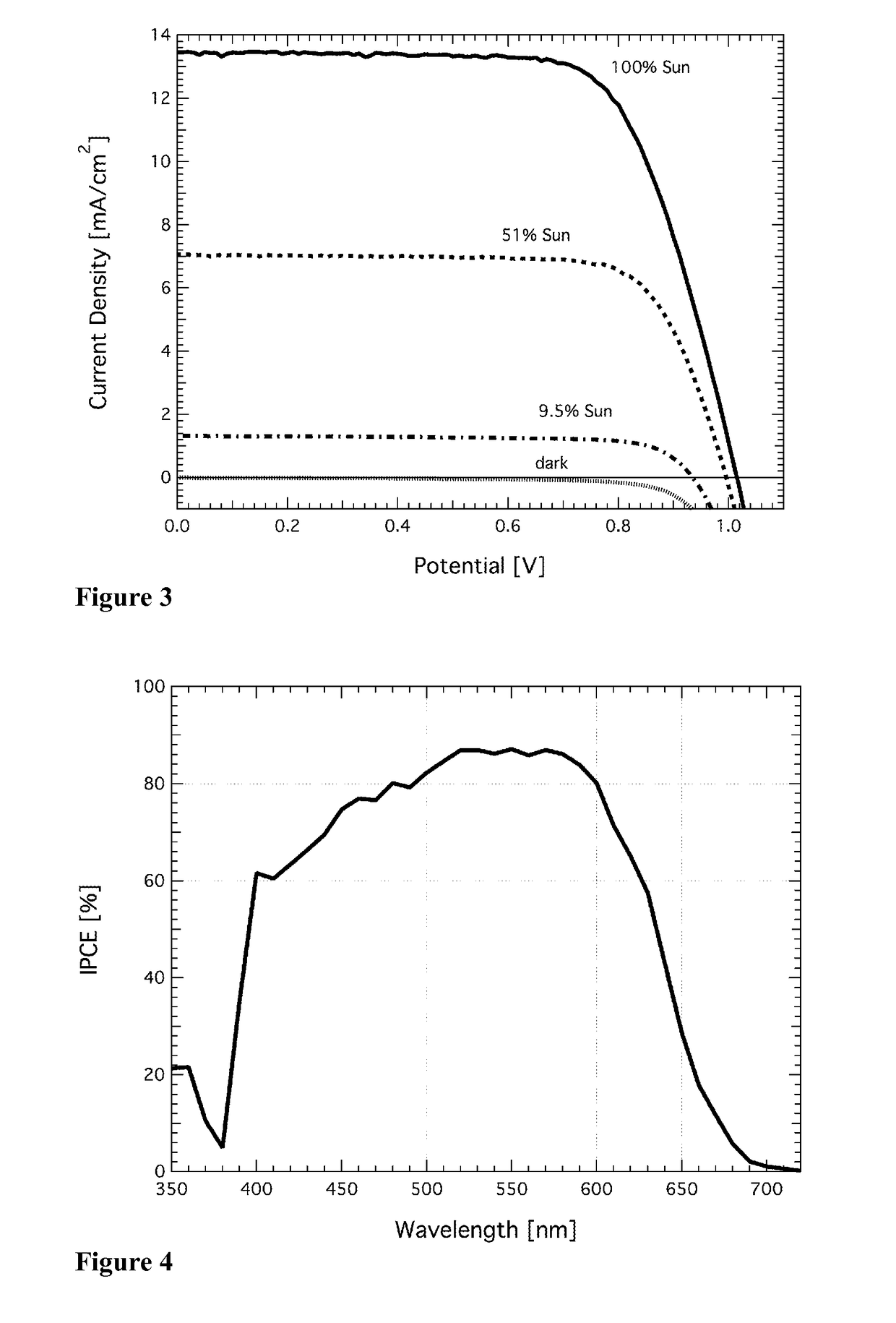Redox couple for electrochemical and optoelectronic devices
a technology of optoelectronic devices and redox couples, applied in the field of complexes, can solve the problems of limiting the open circuit potential of current dsscs to 0 and imposing restrictions on use, and achieve the effects of improving or increasing conversion efficiency, increasing voc, and more stable devices
- Summary
- Abstract
- Description
- Claims
- Application Information
AI Technical Summary
Benefits of technology
Problems solved by technology
Method used
Image
Examples
example 1
Synthesis of Bipyridine-Pyrazole Ligand
[0241]tBuOK (2 g) was added to a suspension of pyrazole (1 g) in dmso (80 mL) and stirred until a clear solution has formed. 6-chloro-2,2′-bipyridine (1 g, from HetCat) was added slowly by portion and the mixture heated at 140° C. for 14 hours. After cooling down to room temperature, water was added and the precipitate filtered and wash with water. The compound was further purified by silica gel chromatography column using Ethyl acetate / diethyl ether as eluent, leading to an off-white crystalline solid (450 mg, yield 39%). Spectroscopic analysis are as reported in the literature (Inorg. Chem. 1991, 30, 3733).
example 2
Synthesis of CoII Complex [Co(II)(bpy-pz)2](PF6)2
[0242]91 mg (0.382 mmol, excess) of CoCl2*6H2O were dissolved in 25 mL of water while in another flask 93 mg (0.418 mmol) of the pyridine-pyridine-pyrazole ligand of Example 1 were dissolved in 25 mL of acetone. The solutions were combined and heated to 55° C. for 2 h. Then 400 mg of NH4PF6 dissolved in 100 mL of water were added to the mixture. The mixture was stored overnight at 3° C. for precipitation. Then the product was collected on a sintered glass frit and dried in vacuo. The pure product was obtained as orange solid and contained compound (70) shown below. Yield: 95 mg (0.12 mmol, 57%). 1H NMR (400 MHz, acetone-D6): δ 112.95 (s, 2H, ArH), 91.83 (s, 2H, ArH), 89.23 (s, 2H, ArH), 75.68 (s, 2H, ArH), 69.31 (s, 2H, ArH), 66.22 (s, 2H, ArH), 43.00 (s, 2H, ArH), 40.74 (s, 2H, ArH), 19.01 (s, 2H, ArH), 13.61 (s, 2H, ArH) ppm.
example 3
Synthesis of CoIII Complex [Co(III)(bpy-pz)2](PF6)3
[0243]91 mg (0.382 mmol, excess) of CoCl2*6H2O were dissolved in 25 mL of water while in another flask 93 mg (0.418 mmol) of the pyridine-pyridine-pyrazole ligand of Example 1 were dissolved in 25 mL of methanol. The solutions were combined and heated to 55° C. for 2 h. The mixture was allowed to cool to room temperature and then H2O2 (1 mL, 30%) and HCl (1 mL, 25%) were added to oxidize the cobalt. The mixture was stirred for 1 h and then 400 mg of NH4 PF6 dissolved in 100 mL of water were added to the mixture. The mixture was stored overnight at 3° C. for precipitation. Then the product was collected on a sintered glass frit and dried in vacuo. The product was obtained as orange solid and contained 65% of the desired Co(III) complex (compound (71)) and 35% of the corresponding Co(II) complex. Yield: 97 mg (0.10 mmol, 49%). 1H NMR (400 MHz, acetone-D6): δ 9.41-9.26 (m, 3H, ArH), 9.00 (t, 3JHH=9.3 Hz, 2H, ArH), 8.47 (t, 3JHH=7.6 Hz...
PUM
| Property | Measurement | Unit |
|---|---|---|
| JSC | aaaaa | aaaaa |
| wavelengths | aaaaa | aaaaa |
| wavelengths | aaaaa | aaaaa |
Abstract
Description
Claims
Application Information
 Login to View More
Login to View More - R&D
- Intellectual Property
- Life Sciences
- Materials
- Tech Scout
- Unparalleled Data Quality
- Higher Quality Content
- 60% Fewer Hallucinations
Browse by: Latest US Patents, China's latest patents, Technical Efficacy Thesaurus, Application Domain, Technology Topic, Popular Technical Reports.
© 2025 PatSnap. All rights reserved.Legal|Privacy policy|Modern Slavery Act Transparency Statement|Sitemap|About US| Contact US: help@patsnap.com



